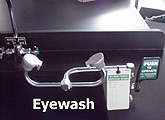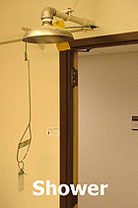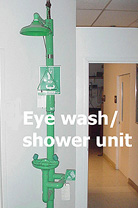Eye Wash and Emergency Shower Guidelines
Last Updated: November 10, 2022 10:54:51 AM PST
Give feedback

Read guidelines for using and maintaining eye wash and emergency shower equipment.
If you work with hazardous chemicals, know the location and how to use the nearest eye wash and emergency shower.
These guidelines apply to all UC San Diego laboratories, shops, and studios.
Location and accessibility
Emergency eyewash facilities and safety showers must be in unobstructed and accessible locations that require no more than 10 seconds for the injured person to reach along an unobstructed pathway. If both eyewash and shower are needed, they must be located so that each can be used at the same time by one person.
There should be no doors in the path of travel; however, if there are doors, there should be no more than one, and it shall swing in the direction of travel.
A travel distance of 55 feet in 10 seconds is cited by the American National Standards Institute (ANSI) as the distance covered by Emergency Eyewash and Safety Shower Equipment by an individual walking at a normal pace.
Consideration should be given to the impaired abilities of the injured victim and the availability of others in the immediate area to assist.
Examples of different types of equipment are shown here:


Use only approved safety equipment.
- Eye wash stations mounted on sinks are valid only if they have 2 orifices.
- Environment, Health & Safety (EH&S) discourages the use of a deluge hose as an eye wash. Deluge hoses are for cleaning glassware or other laboratory activities; they are not inspected by EH&S and may not be sanitary.
- Never rely on sink faucets to replace an eye wash or emergency shower.
Learn how to operate your safety equipment.
- Eye washes and emergency showers are easy to operate. Most equipment is designed for hands-free operation with either paddles, levers, or a pull-lever.
- To turn off, simply reverse the action required to turn it on.
- Ask your Area Safety Coordinator to show you how to use the equipment.
Maintain clearance around your safety equipment.
Keep the area clear at all times around your emergency shower and eye wash, including countertop-mounted eye washes.
- Be aware of electrical hazards. Keep energized electrical equipment away from eye washes and emergency showers.
(Click image to open PDF specifications.)
Make sure safety equipment is in good operating condition at all times.
Make sure the eye wash and emergency shower will be reliable when you need them.
Periodically check the following:
- Cover the eye wash spouts with caps to keep them clean. Caps should be easy to remove in an emergency.
- Look for a current date on the equipment's inspection tag. Eye washes and emergency showers are inspected monthly by EH&S to ensure they work.
- Call EH&S at (858) 534-3660 to report equipment problems or if your eye wash or emergency shower has not been inspected.
Use safety equipment for its intended purpose only.
- Never use safety equipment for cleaning lab or shop equipment, personal objects, or for other non-emergency purposes.
Eye wash operation
Use the emergency eye wash immediately if your eyes are exposed to a hazardous chemical.
The first few seconds after exposure to a hazardous chemical (especially a corrosive chemical) are critical. Delaying treatment, even for a few seconds, may result in irreparable eye damage. Don't hesitate!
Note: Some outdoor eye washes may run discolored (rusty) water for a few seconds. Don't hesitate to use them immediately when needed.
Drains are rarely designed into floor plans to accommodate eye wash stations. Never let that stop you from using the equipment when needed. Call Facilities Management at (858) 534-2930 as soon as possible to collect water where drains are not installed.
To use emergency eye wash:
- Immediately flush eyes for at least 15 minutes.
- Keep the eyes open and rotate the eyeballs in all directions to remove contamination from around the eyes. An injured person may need help holding the eyelids open.
- Call Poison Control Center at (800) 222-1222 for advice, then seek medical attention immediately.
- Have someone bring or fax the Safety Data Sheet (formerly called Material Safety Data Sheet) for the chemical to the doctor.
- Report the injury or exposure. See What to Do if a Work-Related Injury, Illness, or Exposure Occurs.
Resources and regulations
- UC Design Manual
- California Plumbing Code
- California Code of Regulations on Emergency Eyewash and Shower Equipment
Emergency shower operation
Use an emergency shower immediately if your skin is exposed to a hazardous chemical.
The first few seconds after exposure to a hazardous chemical (especially a corrosive chemical) are critical. Delaying treatment, even for a few seconds, may result in irreparable tissue damage. Don't hesitate!
Note: Some outdoor emergency showers may run discolored (rusty) water for a few seconds. Don't hesitate to use them immediately when needed.
Drains are rarely designed into floor plans to accommodate emergency shower stations. Never let that stop you from using the equipment if needed. Call Facilities Management at (858) 534-2930 as soon as possible to collect water where drains are not installed.
How to use emergency shower:- Immediately flush the affected area with copious quantities of water for at least 15 minutes. Protect the eyes from inadvertent contamination.
- Remove contaminated clothing, jewelry, and shoes. Don't let modesty slow you down. Every second counts. Use a clean lab coat to provide the victim with privacy and warmth.
- Call UC San Diego Poison Control at (800) 222-1222 for advice, and then seek medical attention immediately.
- Have someone bring or fax the Safety Data Sheet for the chemical to the doctor.
- Report the injury or exposure. See What to Do if a Work-Related Injury, Illness, or Exposure Occurs.
Questions? Contact the EH&S Research Assistance Program specialist assigned to your building.